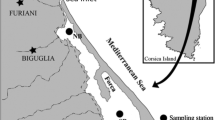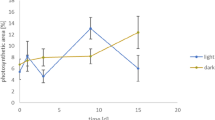Abstract
Cycloclypeus carpenteri is the largest extant benthic foraminifer, dwelling in the deep euphotic zone (a water depth between 60 and 130 m) of the warm oligotrophic Indo-West Pacific. This foraminifer harbors diatom endosymbionts and the foraminifer-microalgal association acts like a holobiont. To verify that light is an important limiting factor controlling the vertical (depth) distribution of living Cycloclypeus holobionts, their physiological responses to light intensity were examined by short-term metabolic measurements and long-term incubations. Net oxygen production (OP) rates measured under different light levels using an oxygen microelectrode indicate that Cycloclypeus holobionts are daily net primary producers adapted to low light levels, with slight photoinhibition (reduced net OP rates relative to a light-saturated rate) over 100 µmol photons m−2 s−1. Long-term growth increments of asexually reproduced juveniles incubated for two months at different light levels ranging from 0 to 100 µmol photons m−2 s−1 show that Cycloclypeus holobionts are adapted to a low light level (∼5 µmol photons m−2 s−1), but can be acclimatized to a certain low light ranges (<50 µmol photons m−2 s−1). These experimental results confirm that light is an important environmental gradient affecting the vertical distribution of Cycloclypeus holobionts.
Similar content being viewed by others
References Cited
Amano, A., Itaki, T., Katayama, H., 2011. Oceanographic Condition in the Southwest off the Okinawa Island. In: Arai, K., ed., Marine Geological and Geophysical Studies around Okinawa Island—Western off of Okinawa Island—Preliminary Reports on Researches in the 2010 Fiscal Year, GSJ Interim Report (55). Geological Survey of Japan, AIST, Tsukuba. 68–75 (in Japanese)
Doo, S. S., Fujita, K., Byrne, M., et al., 2014. Fate of Calcifying Tropical Symbiont-Bearing Large Benthic Foraminifera: Living Sands in a Changing Ocean. The Biological Bulletin, 226(3): 169–186. https://doi.org/10.1086/bblv226n3p169
Fujita, K., Fujimura, H., 2008. Organic and Inorganic Carbon Production by Algal Symbiont-Bearing Foraminifera on Northwest Pacific Coral-Reef Flats. The Journal of Foraminiferal Research, 38(2): 117–126. https://doi.org/10.2113/gsjfr.38.2.117
Fujita, K., Okai, T., Hosono, T., 2014. Oxygen Metabolic Responses of Three Species of Large Benthic Foraminifers with Algal Symbionts to Temperature Stress. PLoS One, 9(3): e90304. https://doi.org/10.1371/journal.pone.0090304
Hallock, P., 1988. Diversification in Algal Symbiont-Bearing Foraminifera: A Response to Oligotrophy? Revue de Paléobiologie, Spéc: 789–797
Hallock, P., Forward, L. B., Hansen, H. J., 1986. Influence of Environment on the Test Shape of Amphistegina. The Journal of Foraminiferal Research, 16(3): 224–231. https://doi.org/10.2113/gsjfr.16.3.224
Hallock, P., Seddighi, M., 2022. Why did some Larger Benthic Foraminifera Become so Large and Flat? Sedimentology, 69(1): 74–87. https://doi.org/10.1111/sed.12837
Hallock, P., Talge, H. K., Cockey, E. M., et al., 1995. A New Disease in Reef-Dwelling Foraminifera: Implications for Coastal Sedimentation. The Journal of Foraminiferal Research, 25(3): 280–286. https://doi.org/10.2113/gsjfr.25.3.280
Hohenegger, J., 2004. Depth Coenoclines and Environmental Considerations of Western Pacific Larger Foraminifera. The Journal of Foraminiferal Research, 34(1): 9–33. https://doi.org/10.2113/0340009
Hohenegger, J., 2000. Remarks on West Pacific Nummulitidae (Foraminifera). The Journal of Foraminiferal Research, 30(1): 3–28. https://doi.org/10.2113/0300003
Holzmann, M., Berney, C., Hohenegger, J., 2006. Molecular Identification of Diatom Endosymbionts in Nummulitid Foraminifera. Symbiosis, 42: 93–101
Hosono, T., Fujita, K., Kayanne, H., 2012. Estimating Photophysiological Condition of Endosymbiont-Bearing Baculogypsina sphaerulata Based on the Holobiont Color Represented in CIE L*a*b* Color Space. Marine Biology, 159(12): 2663–2673. https://doi.org/10.1007/s00227-012-2024-4
Iryu, Y., Nakamori, T., Matsuda, S., et al., 1995. Distribution of Marine Organisms and Its Geological Significance in the Modern Reef Complex of the Ryukyu Islands. Sedimentary Geology, 99(3/4): 243–258. https://doi.org/10.1016/0037-0738(95)00047-c
Itaki, T., Amano, A., Katayama, H., et al., 2011. Bottom Sediments in West off the Okinawa Main Island (Around Kume-Zima and Kerama Islands). In: Arai, K., ed., Marine Geological and Geophysical Studies Around Okinawa Island—Western off of Okinawa Island—Preliminary Reports on Researches in the 2010 Fiscal Year, GSJ Interim Report (55). Geological Survey of Japan, AIST, Tsukuba. 57–67 (in Japanese)
Jeffrey, S. W., Humphrey, G. F., 1975. New Spectrophotometric Equations for Determining Chlorophylls a, b, c1 and c2 in Higher Plants, Algae and Natural Phytoplankton. Biochemie und Physiologie der Pflanzen, 167(2): 191–194. https://doi.org/10.1016/s0015-3796(17)30778-3
Kawahata, H., Fujita, K., Iguchi, A., et al., 2019. Perspective on the Response of Marine Calcifiers to Global Warming and Ocean Acidification—Behavior of Corals and Foraminifera in a High CO2 World “Hot House”. Progress in Earth and Planetary Science, 6: 5. https://doi.org/10.1186/s40645-018-0239-9
Koba, M., 1978. Distribution and Environment of Recent Cycloclypeus. Science Reports of the Tohoku University, 7th Series (Geography), 28: 283–311
Köhler-Rink, S., Kühl, M., 2001. Microsensor Studies of Photosynthesis and Respiration in the Larger Symbiont Bearing Foraminifera Amphistegina lobifera, and Amphisorus hemprichii. Ophelia, 55(2): 111–122. https://doi.org/10.1080/00785236.2001.10409478
Krüger, R., Röttger, R., Lietz, R., et al., 1997. Biology and Reproductive Processes of the Larger Foraminiferan Cycloclypeus carpenteri (Protozoa, Nummulitidae). Archiv für Protistenkunde, 147(3/4): 307–321. https://doi.org/10.1016/s0003-9365(97)80057-7
Langer, M. R., Hottinger, L., 2000. Biogeography of Selected “Larger” Foraminifera. Micropaleontology, 46: 105–126
Lee, J. J., McEnery, M. E., Garrison, J. R., 1980. Experimental Studies of Larger Foraminifera and Their Symbionts from the Gulf of Elat on the Red Sea. The Journal of Foraminiferal Research, 10(1): 31–47. https://doi.org/10.2113/gsjfr.10.1.31
Lee, J. J., McEnery, M. E., Kuile, B. T., et al., 1989. Identification and Distribution of Endosymbiotic Diatoms in Larger Foraminifera. Micropaleontology, 35(4): 353. https://doi.org/10.2307/1485677
Lee, M. J., Ellis, R., Lee, J. J., 1982. A Comparative Study of Photoadaptation in Four Diatoms Isolated as Endosymbionts from Larger Foraminifera. Marine Biology, 68(2): 193–197. https://doi.org/10.1007/bf00397606
Leutenegger, S., 1984. Symbiosis in Benthic Foraminifera: Specificity and Host Adaptations. The Journal of Foraminiferal Research, 14(1): 16–35. https://doi.org/10.2113/gsjfr.14.1.16
Narayan, G. R., Reymond, C. E., Stuhr, M., et al., 2022. Response of Large Benthic Foraminifera to Climate and Local Changes: Implications for Future Carbonate Production. Sedimentology, 69(1): 121–161. https://doi.org/10.1111/sed.12858
Nobes, K., Uthicke, S., Henderson, R., 2008. Is Light the Limiting Factor for the Distribution of Benthic Symbiont Bearing Foraminifera on the Great Barrier Reef?. Journal of Experimental Marine Biology and Ecology, 363(1/2): 48–57. https://doi.org/10.1016/j.jembe.2008.06.015
Oron, S., Abramovich, S., Almogi-Labin, A., et al., 2018. Depth Related Adaptations in Symbiont Bearing Benthic Foraminifera: New Insights from a Field Experiment on Operculina ammonoides. Scientific Reports, 8: 9560. https://doi.org/10.1038/s41598-018-27838-8
Prazeres, M., Renema, W., 2019. Evolutionary Significance of the Microbial Assemblages of Large Benthic Foraminifera. Biological Reviews of the Cambridge Philosophical Society, 94(3): 828–848. https://doi.org/10.1111/brv.12482
Prazeres, M., Uthicke, S., Pandolfi, J. M., 2016a. Changing Light Levels Induce Photo-Oxidative Stress and Alterations in Shell Density of Amphistegina lobifera (Foraminifera). Marine Ecology Progress Series, 549: 69–78. https://doi.org/10.3354/meps11698
Prazeres, M., Uthicke, S., Pandolfi, J. M., 2016b. Influence of Local Habitat on the Physiological Responses of Large Benthic Foraminifera to Temperature and Nutrient Stress. Scientific Reports, 6: 21936. https://doi.org/10.1038/srep21936
R Core Team, 2021. R: A Language and Environment for Statistical Computing. R Foundation for Statistical Computing, Vienna, Austria. https://www.R-project.org/
Renema, W., 2015. Spatiotemporal Variation in Morphological Evolution in the Oligocene-Recent Larger Benthic Foraminifera Genus Cycloclypeus Reveals Geographically Undersampled Speciation. GeoResJ, 5: 12–22. https://doi.org/10.1016/j.grj.2014.11.001
Reymond, C. E., Lloyd, A., Kline, D. I., et al., 2013. Decline in Growth of Foraminifer Marginopora rossi under Eutrophication and Ocean Acidification Scenarios. Global Change Biology, 19(1): 291–302. https://doi.org/10.1111/gcb.12035
Ross, B. J., Hallock, P., 2019. Survival and Recovery of the Foraminifer Amphistegina gibbosa and Associated Diatom Endosymbionts Following up to 20 Months in Aphotic Conditions. Marine Micropaleontology, 149: 35–43. https://doi.org/10.1016/j.marmicro.2019.03.013
Schmidt, C., Heinz, P., Kucera, M., et al., 2011. Temperature-Induced Stress Leads to Bleaching in Larger Benthic Foraminifera Hosting Endosymbiotic Diatoms. Limnology and Oceanography, 56(5): 1587–1602. https://doi.org/10.4319/lo.2011.56.5.1587
Schmidt, C., Kucera, M., Uthicke, S., 2014. Combined Effects of Warming and Ocean Acidification on Coral Reef Foraminifera Marginopora vertebralis and Heterostegina depressa. Coral Reefs, 33(3): 805–818. https://doi.org/10.1007/s00338-014-1151-4
Schmidt, C., Morard, R., Prazeres, M., et al., 2016. Retention of High Thermal Tolerance in the Invasive Foraminifera Amphistegina lobifera from the Eastern Mediterranean and the Gulf of Aqaba. Marine Biology, 163(11): 1–13. https://doi.org/10.1007/s00227-016-2998-4
Sinutok, S., Hill, R., Doblin, M. A., et al., 2011. Warmer more Acidic Conditions Cause Decreased Productivity and Calcification in Subtropical Coral Reef Sediment-Dwelling Calcifiers. Limnology and Oceanography, 56(4): 1200–1212. https://doi.org/10.4319/10.2011.56.4.1200
Sinutok, S., Hill, R., Kühl, M., et al., 2014. Ocean Acidification and Warming Alter Photosynthesis and Calcification of the Symbiont-Bearing Foraminifera Marginopora vertebralis. Marine Biology, 161(9): 2143–2154.https://doi.org/10.1007/s00227-014-2494-7
Stuhr, M., Reymond, C. E., Rieder, V., et al., 2017. Reef Calcifiers are Adapted to Episodic Heat Stress but Vulnerable to Sustained Warming. PLoS One, 12(7): e0179753. https://doi.org/10.1371/journal.pone.0179753
Toki, T., Furukawa, M., Yoshimura, H., et al., 2011. Geochemical and Geological Investigations in the Area around the Southern Ryukyu Islands—Report on RN10 Cruise by T/S Nagasaki-Maru. Bulletin of Faculty of Science, University of the Ryukyus, (91): 9–19
Tsuji, Y., 1993. Tide Influenced High Energy Environments and Rhodolith-Associated Carbonate Deposition on the Outer Shelf and Slope off the Miyako Islands, Southern Ryukyu Island Arc, Japan. Marine Geology, 113(3/4): 255–271. https://doi.org/10.1016/0025-3227(93)90021-m
Uthicke, S., Fabricius, K. E., 2012. Productivity Gains do not Compensate for Reduced Calcification under Near-Future Ocean Acidification in the Photosynthetic Benthic Foraminifer Species Marginopora vertebralis. Global Change Biology, 18(9): 2781–2791. https://doi.org/10.1111/j.1365-2486.2012.02715.x
Uthicke, S., Vogel, N., Doyle, J., et al., 2012. Interactive Effects of Climate Change and Eutrophication on the Dinoflagellate-Bearing Benthic Foraminifer Marginopora vertebralis. Coral Reefs, 31(2): 401–414. https://doi.org/10.1007/s00338-011-0851-2
Vogel, N., Uthicke, S., 2012. Calcification and Photobiology in Symbiont-Bearing Benthic Foraminifera and Responses to a High CO2 Environment. Journal of Experimental Marine Biology and Ecology, 424/425: 15–24. https://doi.org/10.1016/j.jembe.2012.05.008
Walker, R. A., Hallock, P., Torres, J. J., et al., 2011. Photosynthesis and Respiration in Five Species of Benthic Foraminifera that Host Algal Endosymbionts. The Journal of Foraminiferal Research, 41(4): 314–325. https://doi.org/10.2113/gsjfr.41.4.314
Williams, D. E., Hallock, P., 2004. Bleaching in Amphistegina gibbosa d’Orbigny (Class Foraminifera): Observations from Laboratory Experiments Using Visible and Ultraviolet Light. Marine Biology, 145(4): 641–649. https://doi.org/10.1007/s00227-004-1351-5
Ziegler, M., Uthicke, S., 2011. Photosynthetic Plasticity of Endosymbionts in Larger Benthic Coral Reef Foraminifera. Journal of Experimental Marine Biology and Ecology, 407(1): 70–80. https://doi.org/10.1016/j.jembe.2011.07.009
Acknowledgments
This work was partly supported by the JSPS KAKENHI (No. JP17740341). Samples used in this study were provided from those collected during the RN10 cruise (T/S Nagasaki-Maru) and the GH10 cruise (R/V Hakurei-Maru). We thank the onboard scientists and the crew members for their support during the cruise. We also thank the Center for Research Advancement and Collaboration, University of the Ryukyus for the use of a microbalance and a spectrophotometer. The final publication is available at Springer via https://doi.org/10.1007/s12583-022-1612-6.
Author information
Authors and Affiliations
Corresponding author
Electronic supplementary materials
Rights and permissions
About this article
Cite this article
Fujita, K., Kanda, Y. & Hosono, T. Light is an Important Limiting Factor for the Vertical Distribution of the Largest Extant Benthic Foraminifer Cycloclypeus carpenteri. J. Earth Sci. 33, 1460–1468 (2022). https://doi.org/10.1007/s12583-022-1612-6
Received:
Accepted:
Published:
Issue Date:
DOI: https://doi.org/10.1007/s12583-022-1612-6




